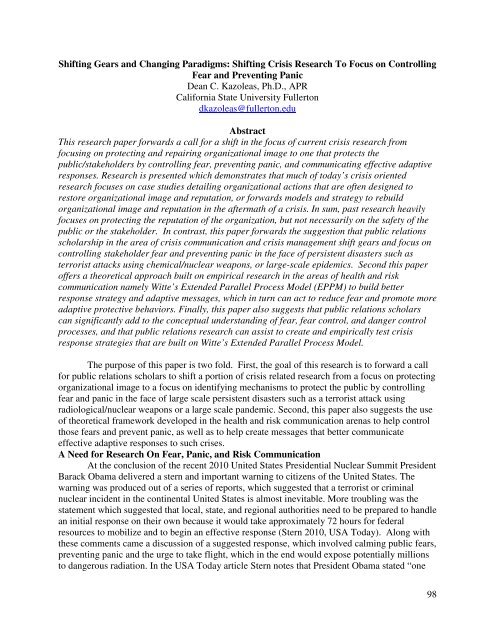2010 - Public Relations Society of America
2010 - Public Relations Society of America
2010 - Public Relations Society of America
You also want an ePaper? Increase the reach of your titles
YUMPU automatically turns print PDFs into web optimized ePapers that Google loves.
Shifting Gears and Changing Paradigms: Shifting Crisis Research To Focus on Controlling<br />
Fear and Preventing Panic<br />
Dean C. Kazoleas, Ph.D., APR<br />
California State University Fullerton<br />
dkazoleas@fullerton.edu<br />
Abstract<br />
This research paper forwards a call for a shift in the focus <strong>of</strong> current crisis research from<br />
focusing on protecting and repairing organizational image to one that protects the<br />
public/stakeholders by controlling fear, preventing panic, and communicating effective adaptive<br />
responses. Research is presented which demonstrates that much <strong>of</strong> today’s crisis oriented<br />
research focuses on case studies detailing organizational actions that are <strong>of</strong>ten designed to<br />
restore organizational image and reputation, or forwards models and strategy to rebuild<br />
organizational image and reputation in the aftermath <strong>of</strong> a crisis. In sum, past research heavily<br />
focuses on protecting the reputation <strong>of</strong> the organization, but not necessarily on the safety <strong>of</strong> the<br />
public or the stakeholder. In contrast, this paper forwards the suggestion that public relations<br />
scholarship in the area <strong>of</strong> crisis communication and crisis management shift gears and focus on<br />
controlling stakeholder fear and preventing panic in the face <strong>of</strong> persistent disasters such as<br />
terrorist attacks using chemical/nuclear weapons, or large-scale epidemics. Second this paper<br />
<strong>of</strong>fers a theoretical approach built on empirical research in the areas <strong>of</strong> health and risk<br />
communication namely Witte’s Extended Parallel Process Model (EPPM) to build better<br />
response strategy and adaptive messages, which in turn can act to reduce fear and promote more<br />
adaptive protective behaviors. Finally, this paper also suggests that public relations scholars<br />
can significantly add to the conceptual understanding <strong>of</strong> fear, fear control, and danger control<br />
processes, and that public relations research can assist to create and empirically test crisis<br />
response strategies that are built on Witte’s Extended Parallel Process Model.<br />
The purpose <strong>of</strong> this paper is two fold. First, the goal <strong>of</strong> this research is to forward a call<br />
for public relations scholars to shift a portion <strong>of</strong> crisis related research from a focus on protecting<br />
organizational image to a focus on identifying mechanisms to protect the public by controlling<br />
fear and panic in the face <strong>of</strong> large scale persistent disasters such as a terrorist attack using<br />
radiological/nuclear weapons or a large scale pandemic. Second, this paper also suggests the use<br />
<strong>of</strong> theoretical framework developed in the health and risk communication arenas to help control<br />
those fears and prevent panic, as well as to help create messages that better communicate<br />
effective adaptive responses to such crises.<br />
A Need for Research On Fear, Panic, and Risk Communication<br />
At the conclusion <strong>of</strong> the recent <strong>2010</strong> United States Presidential Nuclear Summit President<br />
Barack Obama delivered a stern and important warning to citizens <strong>of</strong> the United States. The<br />
warning was produced out <strong>of</strong> a series <strong>of</strong> reports, which suggested that a terrorist or criminal<br />
nuclear incident in the continental United States is almost inevitable. More troubling was the<br />
statement which suggested that local, state, and regional authorities need to be prepared to handle<br />
an initial response on their own because it would take approximately 72 hours for federal<br />
resources to mobilize and to begin an effective response (Stern <strong>2010</strong>, USA Today). Along with<br />
these comments came a discussion <strong>of</strong> a suggested response, which involved calming public fears,<br />
preventing panic and the urge to take flight, which in the end would expose potentially millions<br />
to dangerous radiation. In the USA Today article Stern notes that President Obama stated “one<br />
98
















